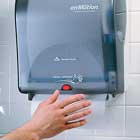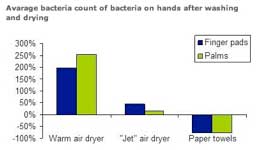
Vol. X, No. 1, January-February 2010
- Editor's Corner - North to Alaska travelogue
- White paper: The Great Recession's long-term impact on consumers and location-based businesses
- Foundations Entertainment University announces 2010 dates
- LAN gaming centers
- News you may have missed
- The Bowl Room & Freeze Club in Kuwait
- Warm air dryers in restrooms increase bacteria on hands
- Current projects
- Upcoming presentations by Randy White
Warm air dryers in restrooms increase bacteria on hands
Warm air hand dryers used in restrooms increase the number of bacteria on people’s hands by more than 250% and greatly increase the potential for spreading germs in the restroom environment. By contrast, using paper towels can reduce bacteria on the hands by more than 75%.
 With the public’s heightened concern about catching the H1N1 flu and other viruses, good hand hygiene is important. It’s especially crucial in public restroom where there’s risk of contamination from germs left behind by others. But it’s not always up to the user. The School of Biosciences at the University of Westminster, London, U.K., recently conducted a study of three types of hand-drying solutions: paper towels, standard warm air dryers and the new generation of “jet” air dryers.
With the public’s heightened concern about catching the H1N1 flu and other viruses, good hand hygiene is important. It’s especially crucial in public restroom where there’s risk of contamination from germs left behind by others. But it’s not always up to the user. The School of Biosciences at the University of Westminster, London, U.K., recently conducted a study of three types of hand-drying solutions: paper towels, standard warm air dryers and the new generation of “jet” air dryers.
Standard warm air dryers performed by far the worst in the tests. They showed an average bacterial increase of 194% on the finger pads and 254% on the palms after washing hands. The results suggest a radical increase in the amount of the Staphylococcus aureus, a type of bacteria known to cause food poisoning, abscesses, boils and potentially penicillin-resistant infections. “The presence of any type of Staphylococcus aureus on the hands of a worker in the food industry or medical field should be taken seriously, as should any increase in its numbers caused by particular hand drying methods,” said Keith Redway, a senior academic at the University of Westminster.
 The study also tested the new type of “jet” air dryer. “Jet” air dryers increase bacteria by an average of 42% on the finger pads and 15% on the palms. Air-based dryers not only cause an increase in bacteria, but can also contaminate the washroom environment and other restroom users. This is caused by high airspeeds of up to 400 mph (over 600 km/h) that blow out of the unit. Tests show bacteria can spread as far as six feet from this type of hand dryer. Standard warm air dryers spread bacteria no further than about a foot.
The study also tested the new type of “jet” air dryer. “Jet” air dryers increase bacteria by an average of 42% on the finger pads and 15% on the palms. Air-based dryers not only cause an increase in bacteria, but can also contaminate the washroom environment and other restroom users. This is caused by high airspeeds of up to 400 mph (over 600 km/h) that blow out of the unit. Tests show bacteria can spread as far as six feet from this type of hand dryer. Standard warm air dryers spread bacteria no further than about a foot.
“The superior performance of paper towels over the two types of dryer in reducing the numbers of bacteria was shown with both the finger pads and the palms of the subjects,” Redway concluded. The test confirmed that using paper is the safest method of drying your hands after washing. In all tests, using paper showed a reduction of bacteria. The average decrease was 76% on the finger pads and 77% on the palms. Also, paper is not likely to contaminate the washroom environment or other users.
Vol. X, No. 1, January-February 2010
- Editor's Corner - North to Alaska travelogue
- White paper: The Great Recession's long-term impact on consumers and location-based businesses
- Foundations Entertainment University announces 2010 dates
- LAN gaming centers
- News you may have missed
- The Bowl Room & Freeze Club in Kuwait
- Warm air dryers in restrooms increase bacteria on hands
- Current projects
- Upcoming presentations by Randy White


